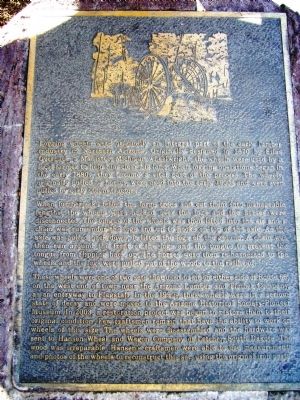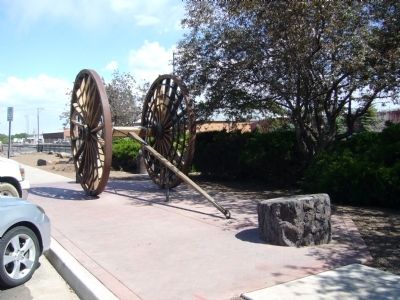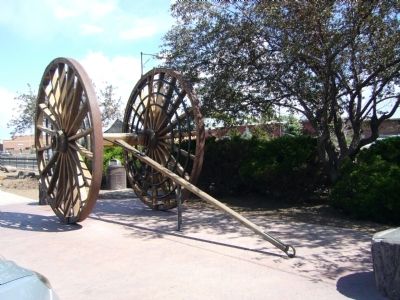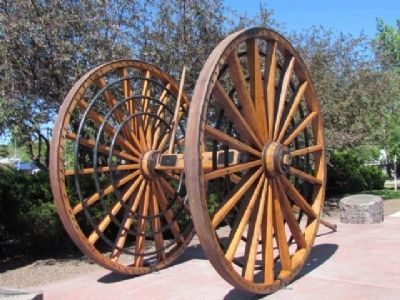Flagstaff in Coconino County, Arizona — The American Mountains (Southwest)
Logging Wheels
When lumberjacks felled the large trees and cut them into manageable lengths, the wheels were backed over the logs and the horses were disconnected. The tongue of the wheels was then lifted into the air and a chain was run under the logs and up to hooks on top of the axle. As the axle was pulled back down, it lifted the logs off the ground. A chain was then run around the front of the logs and the tongue to prevent the tongue from flipping back up. The horses were then re-harnessed to the wheels and the logs were pulled out of the woods to the railhead.
These wheels were one of two sets that used to sit on either side of Route 66, on the west end of town near the Arizona Lumber and Timber Company, as an entryway to Flagstaff. In the 1990's, these wheels were in a serious state of decay and were moved to the Arizona Historical Society-Pioneer Museum. In 2003, a restoration project was begun to restore them to their original condition. Few craftsmen remain that have the ability to work on wheels of this size. The wheels were disassembled and the hardware was sent to Hansen Wheel and Wagon Company of Letcher, South Dakota. The wood was irreparable. Hansen's craftsmen were able to use measurements and photos of the wheels to reconstruct this set, using the original iron parts.
Topics. This historical marker is listed in this topic list: Horticulture & Forestry. A significant historical year for this entry is 1870.
Location. 35° 11.859′ N, 111° 39.012′ W. Marker is in Flagstaff, Arizona, in Coconino County. Marker can be reached from the intersection of Route 66 and South Beaver Street. Marker is in the parking lot on the southeast corner, on the right when entering from Beaver Street. Touch for map. Marker is in this post office area: Flagstaff AZ 86001, United States of America. Touch for directions.
Other nearby markers. At least 8 other markers are within walking distance of this marker. Flagstaff (within shouting distance of this marker); McMillan Building (about 300 feet away, measured in a direct line); a different marker also named McMillan Building (about 300 feet away); Transcontinental Railroad Centennial (about 300 feet away); Railroad Depot (about 300 feet away); Aubineau Building (about 300 feet away); Raymond Building
(about 400 feet away); Telephone Exchange (about 400 feet away). Touch for a list and map of all markers in Flagstaff.
Credits. This page was last revised on June 16, 2016. It was originally submitted on July 20, 2010, by Bill Kirchner of Tucson, Arizona. This page has been viewed 1,632 times since then and 67 times this year. Photos: 1, 2, 3. submitted on July 20, 2010, by Bill Kirchner of Tucson, Arizona. 4. submitted on July 2, 2011, by Bob (peach) Weber of Dewey, Arizona. • Syd Whittle was the editor who published this page.



